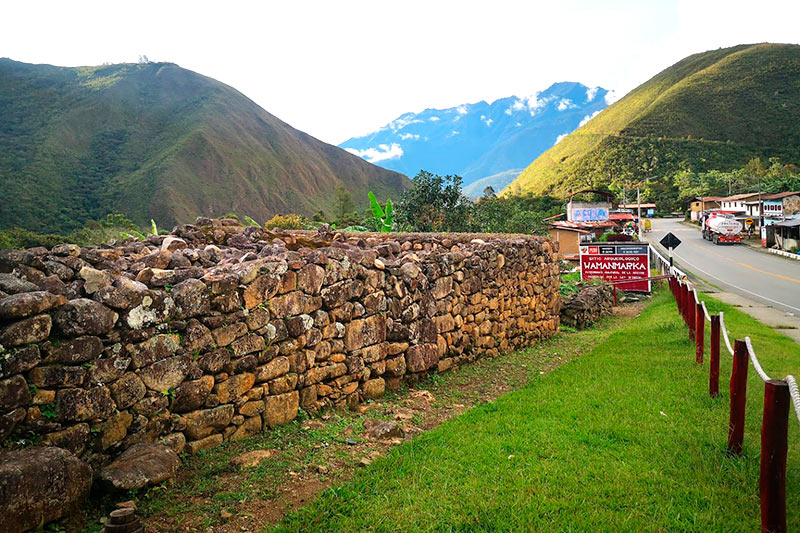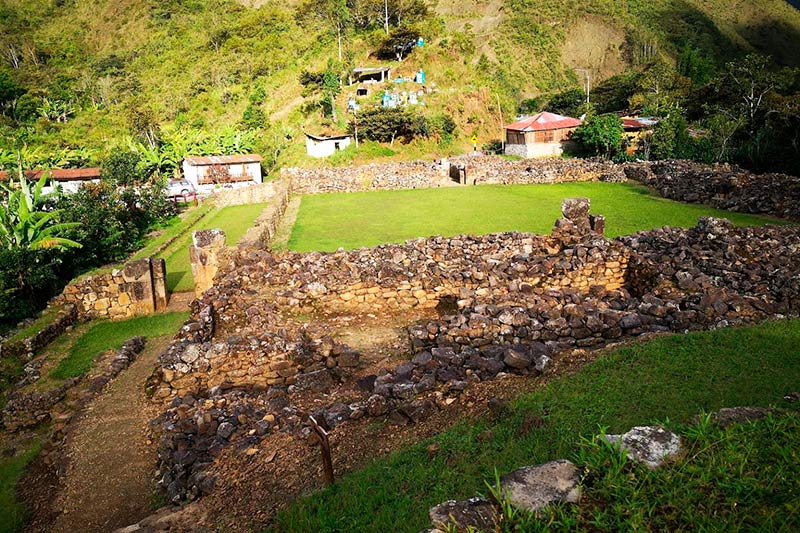Huamanmarca, the entrance to the Cusco jungle
In the district of Huayopata, very close to Santa María in the province of La Convención. Just 40 minutes from Quillabamba, we can visit an archaeological site, which during the time of the Incas represented the starting point for the jungle. Huamanmarca has incredible views and typical structures of the Inca empire.
- What is it?
- What is its location?
- How do you get to Huamanmarca?
- What will you find?
- Some important information
- Entrance fee
- Hours of operation
- Some recommendations
- Frequently asked questions

Huamanmarca – Santa Maria – Cusco
What is it?
Huamanmarca is an Inca archaeological center. The name of this enclosure comes from two Quechua words “huaman” and “marca” which would mean in Spanish “Lands of the falcon”. The remains of these Inca constructions reflect that it was an important ceremonial center and probably represented the beginning or the starting point towards the jungle.
What is its location?
It is located in the district of Huayopata, a few kilometers from the district of Santa María, in the province of La Convención. From Cusco it can be reached through the route to Quillabamba, that is, go up to the Malaga pass and descend to the Cusco jungle. Huayopata is one of the first districts that can be seen after descending from the Andes.
It is exactly 172 km from Cusco, almost four hours of travel. After visiting these constructions, you can visit the district of Santa Teresa, visit the baths Cocalmayo hot springs and do the Coffee Route.
Huayopata is considered the capital of organic tea. Thank you Tea Huyro production.
How do you get to Huamanmarca?
To get to Huamanmarca from Cusco is quite simple. You only have to take a bus on Av. Antonio Lorena in the direction of Santa María. The trip is on a paved road so it is comfortable. Huamanmarca is a few kilometers before Santa María.
What will you find?
Once in Huayopata, getting to Huamanmarca is easy. It is very close to the main road. The access road is through a cobbled path that leads directly to the central square. Most of the structures that can be found have a rectangular floor plan, there are other underground and circular structures.
The main characteristic of the walls is that they are made of stones placed like bricks and set with mud. Like the Inca constructions in Cusco itself. Some stones are carved, others are carved with fine finishes. The roofs were of double water that must have been covered with ichu.
The constructions in the vicinity of the main square are double-walled structures with quadrangular and trapezoidal niches. There are also some bleachers, platforms and some retaining walls. Also, you can find the remains of a colonial church. However, the place that draws all eyes is the circular ushno.

Huamanmarca archaeological remains
Unfortunately, due to looting and some fires, a large part of the archaeological site was damaged.
Some important information
- This complex was discovered by María Rostorowski in 1961. She points out that it was a palace built by the Inca Yupanqui during his rule.
- During Spanish rule it was known as Condormarca.
- There is a record that it was an administrative center that annexed the routes of Cusco and those that currently belong to the Convention, that is, the Cusco jungle.
- From the archaeological remains found and the architecture it can be deduced that it was an important religious center.
- Imperial type buildings can be found.
- Another feature that gives it importance is that it is found as a point of connection with other towns of important apogee during the Tawantinsuyo.
- Currently, thanks to the Regional Directorate of Culture, a good restoration has been achieved.
- So it can be visited, of course, without damaging the site and without causing damage or damaging the buildings.
- During the month of June you can see the “Huamanmarca Raymi”.
Between the walls of Huamanmarca, there is a carved stone that represents a snake or lizard. Indicating that from that point the entrance to the Tawantinsuyo jungle began.
Entrance fee
The archaeological complex of Huamanmarca does not have an access ticket. Admission is free.
Hours of operation
Visiting hours are from 8:00 a.m. to 5:00 p.m. It is recommended to make the visit during the morning and then visit other nearby points such as the Cocalmayo hot springs or visit Quillabamba.
Some recommendations
- Light clothing is recommended. Although when leaving Cusco it is necessary to have some warm clothing. The same for the return.
- Have cash.
- Bring your DNI or identity document.
- Use sunscreen.
- Wear a hat and if possible sunglasses.
- Have mosquito repellent handy.
- Have a raincoat in case it rains.
- Bring water or a hydrating drink.
Frequently asked questions
1. Where is Huamanmarca?
Huamanmarca is in the Cusco jungle. Exactly in the Huayopata district of the La Convencion province. Very close to the main road.
2. Can you only visit Huamanmarca with tourist agencies?
No, but it is the most recommended. If you hire a tourist agency you can enjoy the tour without transportation and food problems. You could even get to Santa Teresa without any problem.
3. What to bring?
It is advisable to bring warm clothing and comfortable shoes, as well as cash and an identity document.
4. How is the weather?
The entire province of the convention is considered the “city of eternal summer”. In rainy seasons, November to May has a temperature from 12°C. at 28°C. While in the dry season, from June to October it has a temperature of 14°C. at 32°C.
5. How long does the entire tour take?
On a trip from Cusco it can take approximately 8 to 9 hours returning to the same city. If you leave from Quillabamba it will only take you between 2 or 3 hours. Once in that place, it is recommended to visit Santa Teresa and all its attractions.
6. When to go?
It is possible to go at any time of the year. Even if it rains it is quite refreshing due to the heat. However, do not forget your raincoat to avoid any inconvenience.
By Ticket Machu Picchu – Last updated, August 15, 2024